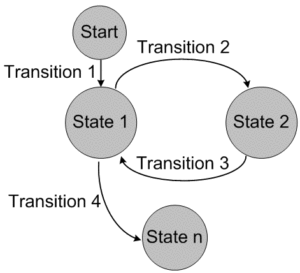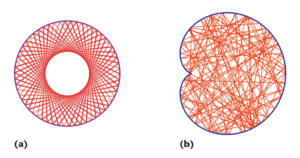Meet me on the Corner of State and Non-Ergodic
Do you know the Edge? It’s one of those web sites I read periodically…a place to seek out new ideas, emerging memes, and interesting discussions. Founded in 1995, they got traction a couple of years later, so this year (2017) they are celebrated their 20th anniversary. The Edge is one of those sites that has survived entirely due to well-considered, intelligent, quality content. Their motto: To arrive at the edge of the world’s knowledge, seek out the most complex and sophisticated minds, put them in a room together, and have them ask each other the questions they are asking themselves.
So I occasionally read postings on the Edge. They ask an annual question of a small group of intellectuals each year and provide the essays in a loosely coupled collection of ideas. Last year, for example, their question was, What do consider the most interesting recent [scientific] news? What makes it important? The responses, as you might imagine, were wide and varied. Have a look here at the table of contents for 2016. Each short essay makes for excellent reading. The collection for 2017 is, as one might expect, are also quite salient.
The Edge question for 2017: What scientific term or concept ought to be more widely known?
Two essays from the 2017 collection I now juxtapose here. The two, by coincidence, hail from two men whose work I have cited before: Stuart A. Kauffman and Scott Aaronson. Both are apparently acolytes of a humanist view of reality, akin to Richard Dawkins, in outlook if not tone. From what I’ve read by Kauffman, whom I do admire, he does leave a little wiggle room for a modicum of awe. But Aaronson appears to exhibit far less humility. They are both highly accomplished men in their fields, and have a right to be unabashed in their views. But, as my father used to say, we all put our pants on one leg at a time. It is from that leveling and loving thought this entry finds inspiration.
As you might guess, the terms suggested by Aaronson and Kauffman map to elements of the title of this blog: State and Non-Ergodic. These are the terms the two gentlemen in question assert should be of greater concern to the scientific community.
Let’s take them separately before comparing. First the concept of state, which comes from Aaronson, a quantum computing expert. In computer science we understand and appreciate finite-state machines — essentially a mathematical model of computation, with emphasis on finite. From Aaronson’s essay, state also containes a system’s hidden reality. Per the essay, state “…determines its [the system’s] behavior beneath surface appearances. But in another sense, there is nothing hidden about a state — for any part of the state that never mattered for observations could be sliced off with Occam’s Razor, to yield a similar and better description.”

Despite his semantic objectionsSemantic objections aside, Aaronson is arguing is not arguing for a soft deterministic model of the universe, or at least but rather a strongly predictable computational model. All we’re missing is an understanding of the hidden variables, to the extent we even need them. This is especially interesting given the fact that Aaronson clearly has a world-class understanding of quantum physics. His reliance on reference to and dismissal of Bohmian mechanics is notable. But the point is, from Aaronson’s perspective, state is actual, or at least computationally highly probabalistic, it as real as real can get, and it even transcends the otherwise indeterminate nature of quantum physics proffered by other interpretations. Per Aaronson, all that what is needed is a fuller understanding of the ‘hidden variables’ of reality. That appears to be Scott Aaronson’s view of the state of objective reality in our discussion.
By contrast, Kauffman (with far fewer words) suggests the term non-ergodic should be the hashtag science trending meme in 2017. To better get our heads around non-ergodic, we first need to understand something of the ergodic hypothesis, which states that “…over long periods of time, the time spent by a system in some region of the phase space of microstates with the same energy is proportional to the volume of this region, i.e., that all accessible microstates are equiprobable over a long period of time.” (Emphasis mine)
So if that is ergodic, then non-ergodic must mean that all accessible microstates are not equiprobable over a longer period of time. 
Kauffman is a biologist, an expert in quantum physics, and probably a bit of a philosopher, though I’m not certain he would agree with all those. He has long been a proponent of the view that the infinite adjacent possible is perhaps entailed by something beyond Darwin’s blind fitness rubric, at least insofar as biology is concerned.
Though an infinite number of combinations of DNA are possible, per Kauffman, only a tiny subset of those have been or will be explored in the entire life span of the known universe. Why? Morphological constraints? Something else? We simply don’t know. But a revolution in thinking implied by Kauffman may very well be the key to unlocking the next door of human understanding. Hence, non-ergodic properties of evolutionary biology ought to be main stream thinking fodder. Because we don’t know why the biosphere, and by implication the universe that contains it, is as it is.
So, on the one hand we have Aaronson, with the view that the Mind of God can be discerned in all cases by simply determining the essential hidden variables (via a highly probabilistic computational model). And on the other, Kauffman, who sees confounding patterns, but implies this too may simply require better understanding of the hidden variables of nature to yield a non-ergodic model — which too would rival the Mind of God in ambition.
See how I introduced the concept of “the Mind of God” there? I thought that was clever of me. By this I do not necessarily mean the book by that name, though I am confident Paul Davies did a fine job of framing the argument for a creative deity as root cause as may be possible from a scientific perspective. But rather something simpler — the Mind of God as the designer of (human) consciousness itself, which is something we really don’t understand from a scientific perspective.
Per Aaronson, the quantum slit experiment would does not harbor randomness at all. And maybe he is correct. See this article on Bohmian pilot wave theory. But if the universe is essentially a predictive computational engine with no room for quantum uncertainty, then it must also follow that the human brain, which is comprised entirely of the stuff of the universe, must also be similarly entailed.
I turn to my friend Dr. Kauffman, smiling wryly on the corner of State and Non-Ergodic. I think he was recalling Dean Radin’s talk in Tuscon in 2016. Yeah….human consciousness. There’s the rub. Regardless of what pilot wave theorists may think, there is something special, measurable, and repeatable about the observer. And statistically, we can prove it.
So let’s agree to meet at the corner of State and Non-Ergodic. We can decide which way to turn after we’re there.
Happy 2017!
UPDATE: Per a comment from Scott Aaronson, he was not and is not advocating a Bohmian interpretation of Quantum Mechanics. He explicitly states, “…a state might only determine the probabilities of various observations, not the observations themselves.” He goes on to further state quite clearly that he personally “…regard[s] the indeterminism of quantum measurement outcomes as a settled fact, to pretty much the extent anything in physics is a settled fact.” I am appreciative of the clarification. Hence, the updates to my original post with much gratitude. Please adjust digestion of above blog entry accordingly.